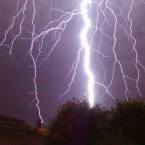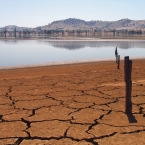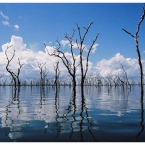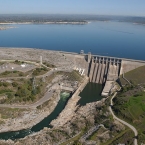How Dams Can Kick up a Storm and Change Our Climate
Only 140 kilometers from our Berkeley office, the Folsom Dam towers 100 meter high over the American River. When it was built in the 1950s, the project was supposed to withstand the most severe flood in 250 years. Yet after it was completed, strong floods suddenly became more frequent and overtopped the dam at several instances. Until a safety upgrade goes forward, 440,000 people in the downstream area are exposed to the highest level of flood risk in the US. Scientists have now found evidence that the project’s problem may be partly of its own making, and that dams can in fact kick up a storm.
We have known for a long time that dams can influence local rainfalls. Humidity evaporates from reservoirs and irrigated fields and gets recycled as rainfall. Dams and levees can reduce evaporation and rainfalls when they drain wetlands and open up woodlands for deforestation. The Niger Delta in West Africa is an example. In September, the delta’s wetlands extend to 30,000 square kilometers – roughly the size of Belgium – and feed rainfalls over a much larger region. Yet existing and proposed dams on the Niger would reduce the river’s flow by almost half. Christopher Taylor of the Centre for Ecology and Hydrology warns that this could “significantly reduce” the seasonal window when the delta induces rainfalls.
This spring, a devastating drought crippled large part of Central China. Local people maintain that droughts have become more frequent and severe since the massive Three Gorges Dam on the Yangtze River was completed in 2003. If you look at the immediate impacts, this does not appear to the case. Chinese researchers found that after 2003 rainfalls decreased somewhat south of the reservoir, and increased significantly about 100 kilometers to the north.
Yet the Three Gorges Dam may have more significant indirect impacts. During the flood season, the Yangtze used to expand the size of the Dongting and Poyang lakes from about 4,000 to 24,000 square kilometers. By storing flood water for electricity generation, the Three Gorges Dam is now greatly diminishing the seasonal expansion of the two flood basins, which had already been dwindling due to land reclamation. During this year’s drought, the majestic Dongting Lake – the home of the famous Chinese dragon boat races – turned into a sad mudflat with isolated pools of water.
The hydropower operators released extra water from the Three Gorges Dam in late May, claiming that they thus contributed to the drought relief. This is disingenuous: without the dam, much more water would have replenished the flood basins naturally. Research on wetlands and climate around the world suggests that chocking off the Yangtze’s flood basins is likely to have significant negative impacts on rainfalls that cannot be compensated by evaporation from the Three Gorges reservoir.
Reservoirs don’t only influence rainfall and droughts in their vicinity. They also contribute to climate change by emitting greenhouse gases. Rotting organic matter from the vegetation flooded when the reservoir is filled releases methane and carbon dioxide. The plankton and plants that live in the reservoir, the detritus washed down from the watershed, and the seasonal flooding of plants along the reservoir fringes ensure that emissions continue for the lifetime of a reservoir. Greenhouse gas emissions are particularly high from shallow tropical reservoirs. Philip Fearnside of the National Institute for Research on the Amazon calculated that three hydropower projects in Brazil emit greenhouse gases approximately twice as high as the emissions of modern coal-fired power plants with the same energy output.
Ivan Lima of Brazil’s National Institute for Space Research estimated the total methane emissions from large dams at 104 million tons per year. This is around 4% of human-made climate change – equal to the contribution of the civil aviation industry. Just as flying is not a sustainable form of transport, hydropower can not be considered a renewable form of energy.
Three researchers from Tennessee Technological University and the University of Colorado have now made the latest contribution to the debate on dams and climate change. By overlaying a databank of large reservoirs with meteorological stations all around the world, they found that dam building has influenced the severity of storms. In Southern Africa and Southern Europe, dams “appeared to have increased extreme precipitation by as much as 20% during the last century.” A smaller increase occurred in India and Central Asia.
In a separate study, a group of scientists around Faisal Hossain and Roger Pielke Sr. found “the possibility of storm intensification in impounded basins of the Mediterranean and arid climates of the United States.” This region includes the Folsom Dam on the American River. Comments Hossain: “Now, our results give us a better idea of which dams are most likely to gradually change local climate and what that means for managing those reservoirs as time passes.”
Climate change puts dam builders in a bind. Changing rainfall patterns make it difficult to assess future streamflows, while more frequent storms can make dams unsafe. The US government has approved $1 billion for a safety upgrade of the Folsom Dam. This is a price which many governments in poor countries cannot afford. They need to diversify their energy sectors and build decentralized projects which are more resilient to the vagaries of climate change than bulky large dams.
Peter Bosshard is the policy director of International Rivers. He blogs at www.internationalrivers.org/en/blog/peter-bosshard and tweets @PeterBosshard.






